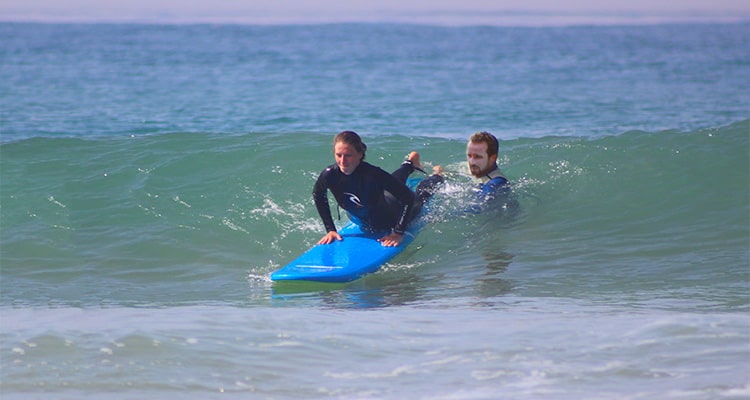The day has finally come. You’ve rented or borrowed boards from friends and sure enough, you’ve got the bug. It’s time to surpass your past self and take the leap into the great blue beyond. It’s time to find your partner in crime, your flotation device in rocky waters, your board. Correctly choosing your first surfboard can mean the difference between a smooth entry and a rude awakening.
1. Choose A Board With High Buoyancy
The thicker your board, the easier getting or regaining your balance will be. Thicker boards pop up to the surface quicker and are much more forgiving of mistakes. This is crucial when you’re just starting out and will be much easier to pop up on and thus less discouraging than more advanced boards.
2. Don’t Overspend On Your First Board
If this is your first time out on the waves, you may be doing a lot of bumping and banging, and your board will show it. Until you are confident and moderately knowledgeable in surfing, an expensive board will quickly become a $400 beat-up board.
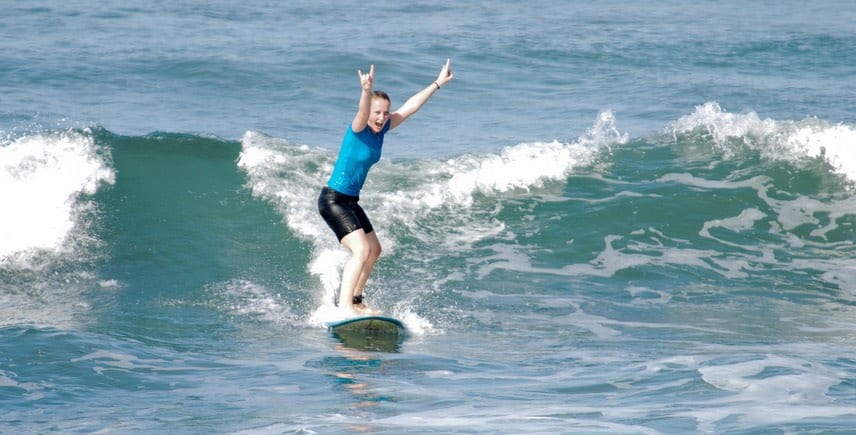
3. Choose A Wide, Stable Board
Thin, narrow boards look impressive, but a beginner should select something thicker and with more weight. These boards are heavier but provide a sturdier platform for the novice surfer. They allow for faster paddling and pop up faster than their professional counterparts.
4. Choose A Thick Board
When you’re starting off it’s important to get a board that will give flotation and allows for easy paddling. A good average size board for a beginning surfer would be around 7 feet long and 19-21 inches wide and at least 2-3 inches thick.
This all depends on your size, so be sure you can comfortably carry and wield the surfboard in the water. Just make sure your surfboard stands at least a foot taller than you. Generally, a 120-pound surfer should look for a 6 feet 10-inch board while a 140 pounder might look towards a 7 feet 2-inch board. At 170 pounds, try to go above 7 feet 6 inches.
5. Choose a Board that Reflects Your Skill Level
Picking a board meant for advanced surfers when you are at an intermediate level is the wrong move. Stick with something that allows for growth and improvement, and think of your ultimate goal as a surfer.
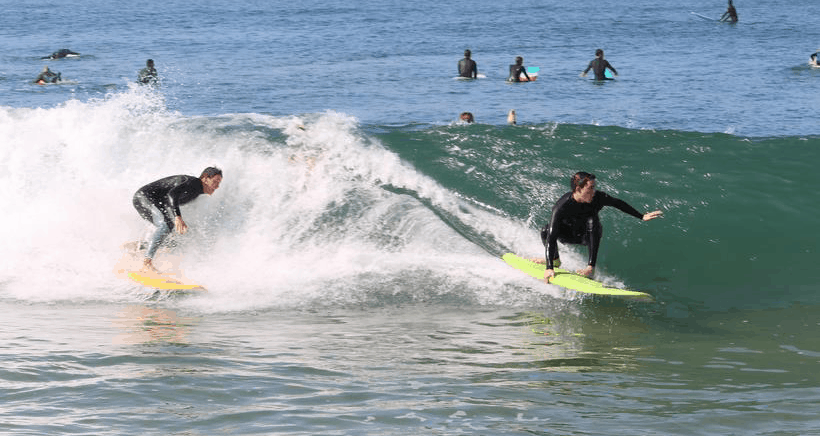
6. Don’t Worry About The Number of Fins
Chances are, you aren’t going to be learning maneuvers in your first, second, or even tenth lesson. So looking at fin shapes at this time is unnecessary. While a board with three fins may look cooler, it doesn’t do the beginner any favors.
7. Don’t Be Fooled By Shiny Things
You wouldn’t buy a Lamborghini for a kid just getting their driver’s license. Of course you wouldn’t. You’d buy them a car they can beat on as they learn the rules of the road. Same thing goes with buying your first surfboard. A user-friendly board is going to help you catch more waves, get to your feet easier and keep the stoke level high. You’re going to have to work your way up to that magic glass slipper you’ve been eyeing in the surf shop window.
8. Start Off Soft
If you’re just getting into surfing for the first time a soft-top or foam surfboard is the way to go. They’re virtually indestructible and offer all the stability you could as for as you get your feet under you. They’re also easy to find and relatively affordable. You can pick up soft-tops at Costco for less than $100. Sporting goods stores usually carry them during the summer season. And a number of companies like Catch Surf and Beater Boards are making fun, stylish boards that work well and are available at your local surf shop or online.
If you have ever participated in a surf lesson, chances are you rode a “foamie.” These soft surfboards became the most common beginner board as their prices dropped significantly; and now most experienced surfers have even adopted them as a part of their arsenal. The large volume adds stability that is crucial when learning to stand and balance. The completely foam build adds buoyancy, which makes paddling and wave catching much easier.

9. Go Long! (board)
For those that have gotten the hang of riding waves on a friend’s soft-top and are looking to step it up, consider a fun board or a longboard. A fun board is typically any full-volume board between 7’ and 9’ in length. The longer the board the easier it’s going to paddle and catch waves.
However, a longer board does come at a cost. A 9’ board can be difficult to control in the ocean and they’re nearly impossible to duck dive unless you’re an experienced surfer. However, a fun board is still a good option if you’re starting to work out your bottom turn and carves. Shortboards are great for punching through the surf line and high-performance surfing, but learning on a small board can be difficult.
Longboards are a great choice for most surfers starting out. They are also great choices for the surfer who is no longer quite so agile, or who weighs a little more than they did in their teens. Longboards are very forgiving surfboards and are ideal for the beginner, the older surfer, the surfer getting back into it after a break, or any surfer that just wants to maximize the number of waves you catch.
10. Longer Boards, More Waves
Longboards make it easier for you to catch waves. With this in mind another reason for selecting a bigger board is that the more volume a board has, the easier and earlier it will catch waves. Longboards will also allow you to catch shorter waves. A longboarder will be able to catch and ride far smaller waves than is possible for the short boarder. Little fun waves are great for confidence building and are far less exhausting when you need to practice over and over and over again to get it right.
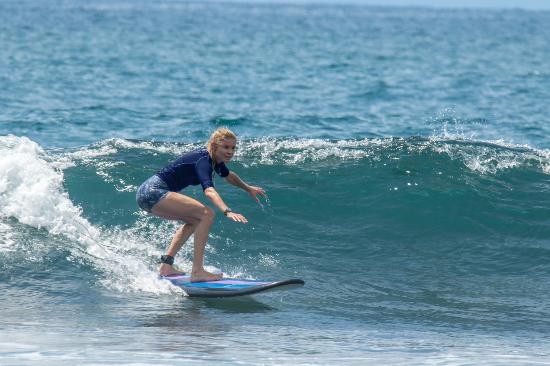
11. Buy Used
There’s no reason to walk out of a surf shop with a shiny new board if it’s your first one. Save your money for a better performing board when you’ve gotten a little better. Most shops have a used rack where you can pick up an inexpensive board.
Craigslist is also a great source for used boards. But make sure the board is in good shape before you buy. If the glass is buckled anywhere or its riddled with dings keep looking. The last thing you want to do is buy a board that’s going to break or require massive repairs. There are a lot of gems out there in the used market, put in the time searching and wait for the one that speaks to you.
12. Your First Surfboard Should Be Cheap
While learning how to surf, you’re going to ding and scratch a board if you really put it to use, so don’t spend too much cash. A $400 surfboard will ding as easy as a $100 surfboard. It’s not about looks, so ignore minor yellowing and small dings.
However, dings that show foam or any delamination should be avoided. As a beginner, you’re going to beat the heck out of your surfboard, so pay the least amount of cash possible.
13. Buy A Board For The Surfer You Are Now
Pick a surfboard for you, your body and skill level. Your age, weight, and fitness level will play an important part in your decision, and so will the types of waves and beaches you surf in, as well as your ability. Your surfboard is a mirror of you, so pick one that is appropriate for the surfer you are now, and not necessarily the one you want to become.
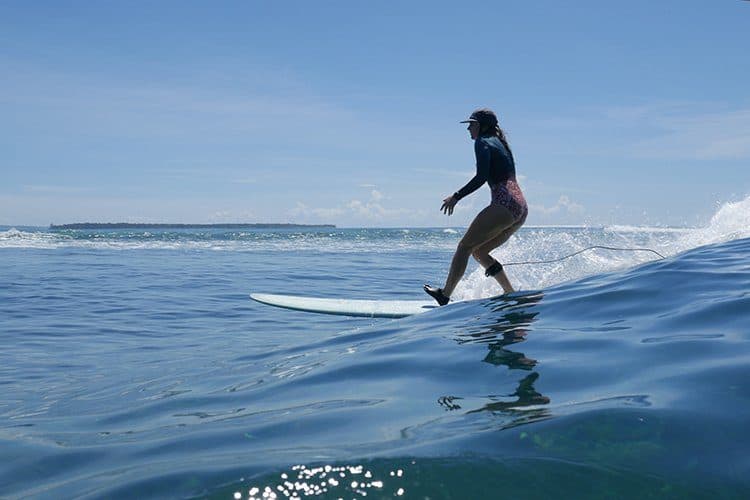
14. Don’t Worry About Surfboard Shape
Don’t worry about the tail shape or number of fins on your surfboard. These parts of a surfboard shouldn’t matter. For the first 3-6 months, you really shouldn’t worry about turning or doing maneuvers anyway, so whether your surfboard is a swallowtail or a pintail or even if your surfboard only has one fin is pointless.
But for future reference, 3-fin boards are the easiest to turn and the most functional fin set up for the advanced and intermediate surfer.
15. Don’t Overvalue Aesthetic
Many of the things we are drawn to as purchases are in some way beautiful or we are led to make selections by colors and lines that appeal to us. A surfboard will be no different. This is especially true if you are buying new.
You will wander round the shop which is full of shiny, polished beauties and be attracted by funky logos and fantastic graphics. But it is the last reason on earth to buy a surfboard. Of course it will come into the decision at some point, no-one wants an ugly board, but it comes low down on a list of what is important in selection.
Besides anything else that shiny new surfboard won’t stay shiny and polished for long. The minute you want to ride it that beautiful design will be covered over with a layer of wax which is what a surfer uses to make the deck of his board non-slippery. So make sure you get a board that suits your needs and worry about looks later.
16. Don’t Overvalue Deck Design
More often than not, you will be tempted to make your choice based on its deck design. Don’t do it. The cocky strut you will have from toting around your super cool board will soon fade as soon as you realize that your board doesn’t perform how you want it to.
17. Avoid Short Surfboards At First
The other common error made by beginner surfers is to try and hop straight onto a short board. You may picture yourself slashing those waves on a fancy little 6 feet long, pointy nosed thing no wider than a toothpick but if you start off with the wrong board you may never end up shredding the sweet waves of your dreams.
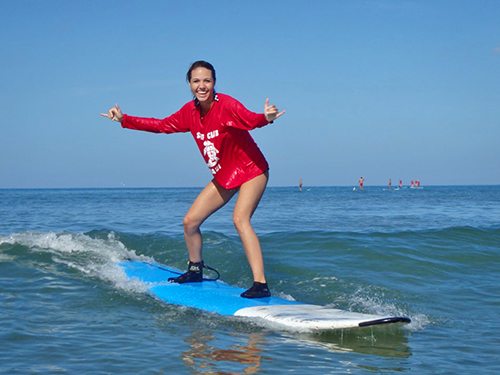
18. Try Going For A Mal
When it comes to your first board, size matters. An extra long longboard or Mal (short for Malibu) is a board that measures in excess of 9 feet and has a rounded nose and tail.
A mini Mal or funboard, which as the name suggests is a smaller version of a Mal, can measure anything from about 7 feet 6 inches to 9 feet. When you’re starting out, a Mal or mini Mal are good choices. If you are shorter or lighter then you will be okay with a mini Mal. Both of these boards are good choices because longboards are more stable and allow for easier paddling. This is due to longboard’s being more buoyant, which allows them sit higher in the water. They also have a larger surface area, which takes less energy to paddle it.
19. When In Doubt, Go Wide
Surfboards are not just measured in length, but also in width and thickness. Do not assume that every longboard will automatically be the easier option for a beginner.
To many, longboarding is still the purest and most soulful form of surfing. In recent years there have been many opinions on the longboard/shortboard debate. Some think longboarding is more pure but many imagine tight turns on a shortboard, when they think of surfing.
But if you were to actually ask any top surfers, they’d tell you that they have both long and short boards in their collection. A true surfer just wants to ride waves and will have the best equipment for any condition or wave type at the ready. So don’t think that all longboards are created equal. Many surfers have boards with many different lengths and widths for different occasions. So here’s a rule of thumb for beginners: when in doubt, look for wider and thicker dimensions that will increase your board’s volume.
20. Don’t Get Lost in Minor Details
The shape of the board, its nose, tail and rails and its rocker (whether a board lies completely flat on the ground and its levels of deviation from this in the form of concavity) will all vary greatly. The variations in these are endless and it is perhaps better as a novice to not get too tied up in them. Generally just look for rounded shape nose and tail. Worry about the nitty gritty details once you have a few more boards in your collection.

21. Pay Special Attention To The Make Of The Board
The other thing to be considered is what should your board be made of? Until relatively recently all surfboards were made one at a time by hand and by highly skilled ‘shapers’. This often made them expensive and no two boards were ever exactly the same.
With recent developments in surfboard design, some boards are mass factory produced and made from different materials to the original fiberglass covered foam core board strengthened by a stringer (or wood strip) down the middle. Composite Epoxy resin boards are often a very good choice for the beginner. They are resistant to damage, often lighter and, because they are mass-produced, far cheaper. They also retain their value a lot more because they are less likely to be damaged.
You may also come across the soft top board or foamie which is made completely of foam. These are very thick and very stable and are often used in surf schools for the reasons just given but also because they are more forgiving should you get knocked or hit by them whilst in the water which make them perfect for beginners.
22. Be Careful When Buying Used Boards
If your budget allows it, it’s certainly more ideal to buy a new board but for many this isn’t feasible or simply not cost effective for a first board. If that’s the case, second-hand boards are a great option. In addition, individuals selling boards will often throw in fins, leashes and board bags all of which can be costly if bought separately.
While online sellers can be honest advertisers and provide full photographic evidence of any damage, be reasonably wary. Unless you are truly confident that the seller knows what they’re talking about and is trustworthy, you may well find yourself as the proud new owner of a totally useless board.
Things to look for in second-hand boards are cracks, holes and dents in the fiberglass. If these have penetrated to the foam beneath they can still be fixed but may be costly to do so. In time you will learn to do your own minor repairs but for now, be aware that repairs don’t come cheap. The buyer may consider dropping the price for this if you know your stuff. If the board is still covered with wax an enormous amount of damage can be hidden from you so make sure the board’s cleaned and hosed down before you purchase it. Always be a little wary if the seller hasn’t stripped the wax from the board they are trying to sell you.
Above all, the most important thing is to check when getting a new board is for areas of the board that feel spongy to the touch or give way when you press on them. This is a sign that water has got into the foam core and delamination between layers has occurred. In most cases this will mean the board is unfixable and useless. Avoid this at all costs.
23. Keep Your Height And Weight In Mind
Basically, the taller you are and the more you weigh, the longer and thicker the surfboard will need to be. As a generalization, opt for a surfboard that is 2 to 3 feet longer than you. A surfboard that is 2 to 3 inches thick and is about 21 inches across should be about ideal for beginners to intermediate adult surfers. This can make all the difference.
24. Consider Your Age
Kids and teens weigh a lot less than adults and are a lot more agile with getting to their feet. Therefore, beginner boards for kids tend to be a lot lighter and smaller. Really young children can start on foam surfboards which are far more forgiving in collisions, being a lot softer. Kids who have had a bit of surfing experience need only a surfboard 6 to 18 inches longer than themselves. Unless you want to be lugging their surfboard everywhere for them, it can be a great idea to ensure that they can carry the surfboard weight wise, and secondly, that it fits under their arm. If they are too small to be able to tuck it under their arm, make sure they can carry it on their head.
25. Keep Safety In Mind
This applies mainly to those who are buying a board for their kids. Several companies make soft surfboards that consist of a bodyboard-like material, and the fins are flexible to help prevent injuries while learning your craft. This is a good way to get the kids up and riding without a ride to the emergency room.
26. Know What Waves You’ll Be Surfing
Are you planning on catching small waves or big waves? Perhaps it is smartest to start out with smaller waves and work up. Check out the usual size of the waves where you plan on going surfing. As a rule, longboards are going to be perfectly suitable for catching smaller waves.
27. Consider Your Budget
Custom made surfboards cost a lot more than ready made boards. Unless you have plenty of cash to burn it makes sense to make the first surfboard purchase cheaper. Your first surfboard will get dinged around a lot. Once you know how often you will be surfing and what sort of maneuvers you want to do out there in the water then you can select something more to your individual requirements.

28. Consider A Fish Surfboard
Fish surfboards offer stability, flotation, and also a lot of movement on the wave. Fish surfboards are easy for paddling and catching waves. Fish surfboards are shorter in length and wider and thicker than the usual surfboard formula from above. These surfboards can be a great selection for the surfer looking for fun and great moves. Fish surfboards can be ideal for the surfer who has the basics down and wants an additional challenge.
29. Ask The Experts
Whatever your skill level, the best advice you’re going to get is from the guy or girl with wetsuit tan lines at the surf shop near your local beach.
People who work in board shops will be able to find a board that suits your skills, your body and the beaches you’re surfing. You can walk in and talk to somebody about where you’re surfing, what you’re looking to do, and they can put you on the right board. And honestly, that’s not something you’re going to get buying something online.
30. Try Before You Buy
The right board is the one that’ll help you catch waves and become a better surfer. If you’re just starting out, surf instructors can be a great source of advice.
If you have a good time on a particular board during a lesson, ask the instructor for details and whether it’s suitable for your skills. Many surf shops will let you trial or hire a board before making a purchase, which can help you avoid something unsuitable. Talk to the person you’re renting from and listen to their advice about where to surf, too.
Final Tips
So now you should be equipped with enough gnarledge (gnar knowledge) to buy your first board with confidence. Selecting the right board from the jump will save you countless frustrating hours in the ocean. Buying the wrong board can have you struggling to clear the first hurdle before you even get to the races. This can even bruise your ego to the point where you consider giving up all together.
But once you buy the board that’s suits your need perfectly, the rest is an offshore breeze. From the moment you catch your first wave, you’ll be initiated in a league of surfers all over the world who tap into the infinite power of the ocean; endlessly searching for that perfect wave. Happy surfing!

